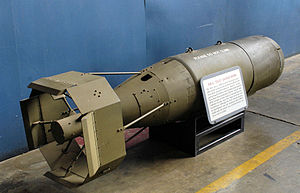VB-6 Felix
| VB-6 Felix | |
|---|---|
 VB-6 Felix Guided Bomb | |
| Type | anti-ship missile / guided bomb |
| Place of origin | United States |
| Service history | |
| In service | never used operationally |
| Wars | World War II |
| Production history | |
| Designer | National Defense Research Committee |
| Produced | 1945 |
| Specifications | |
| Mass | 1202 lb (545 kg) |
| Length | 91.2 in (231.6 cm) |
| Diameter | 18.6 in (47.2 cm) |
| Warhead | amatol explosive |
| Warhead weight | 1000 pounds (454 kg) |
| Engine | none |
Guidance system | infrared |
The VB-6 Felix was a precision-guided munition developed by the United States during World War II. It was one of the precursors of modern anti-ship missiles.
Created by the National Defense Research Committee, Felix relied on infrared to detect and home on targets, in clear weather, especially ships at sea at night. It was this property which earned the weapon its name, after the ability of cats to see in the dark ("Felix the Cat" was an extremely popular early-20th century cartoon character).
Felix was a 1000-pound (454 kg) general purpose (GP) bomb with an infrared seeker in the nose and octagonal guidance fins in the tail. Unlike other weapons, such as the German Fritz X, Felix was autonomous (what a later generation would call fire-and-forget), though there was a flare in the tail for tracking.
Successful trials led to Felix being put in production in 1945, but the Pacific War ended before it entered combat.
Sources
- Fitzsimons, Bernard, editor. "Felix", in The Illustrated Encyclopedia of 20th Century Weapons and Warfare. Volume 9, p. 926. London: Phoebus Publishing, 1978.
See also
